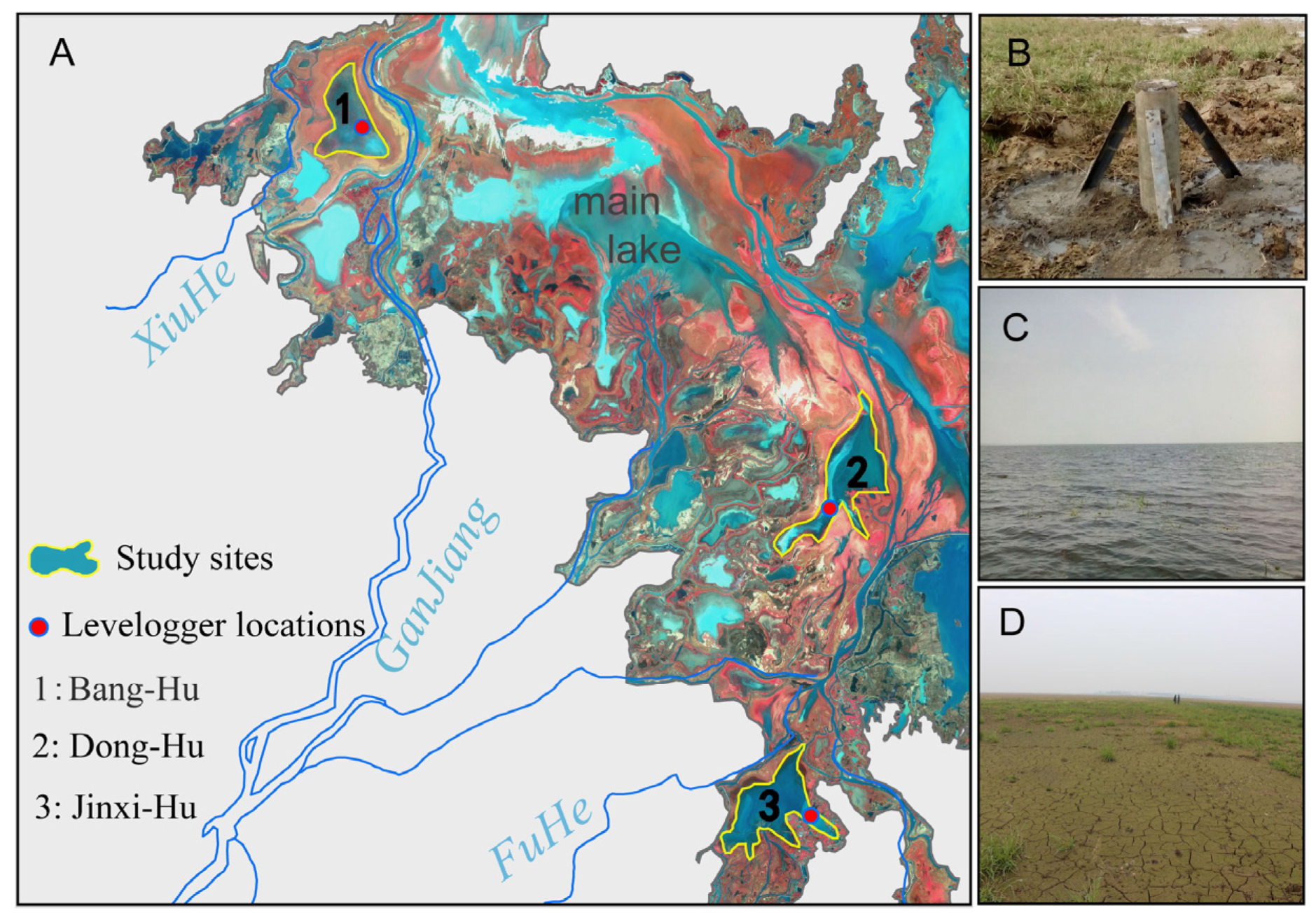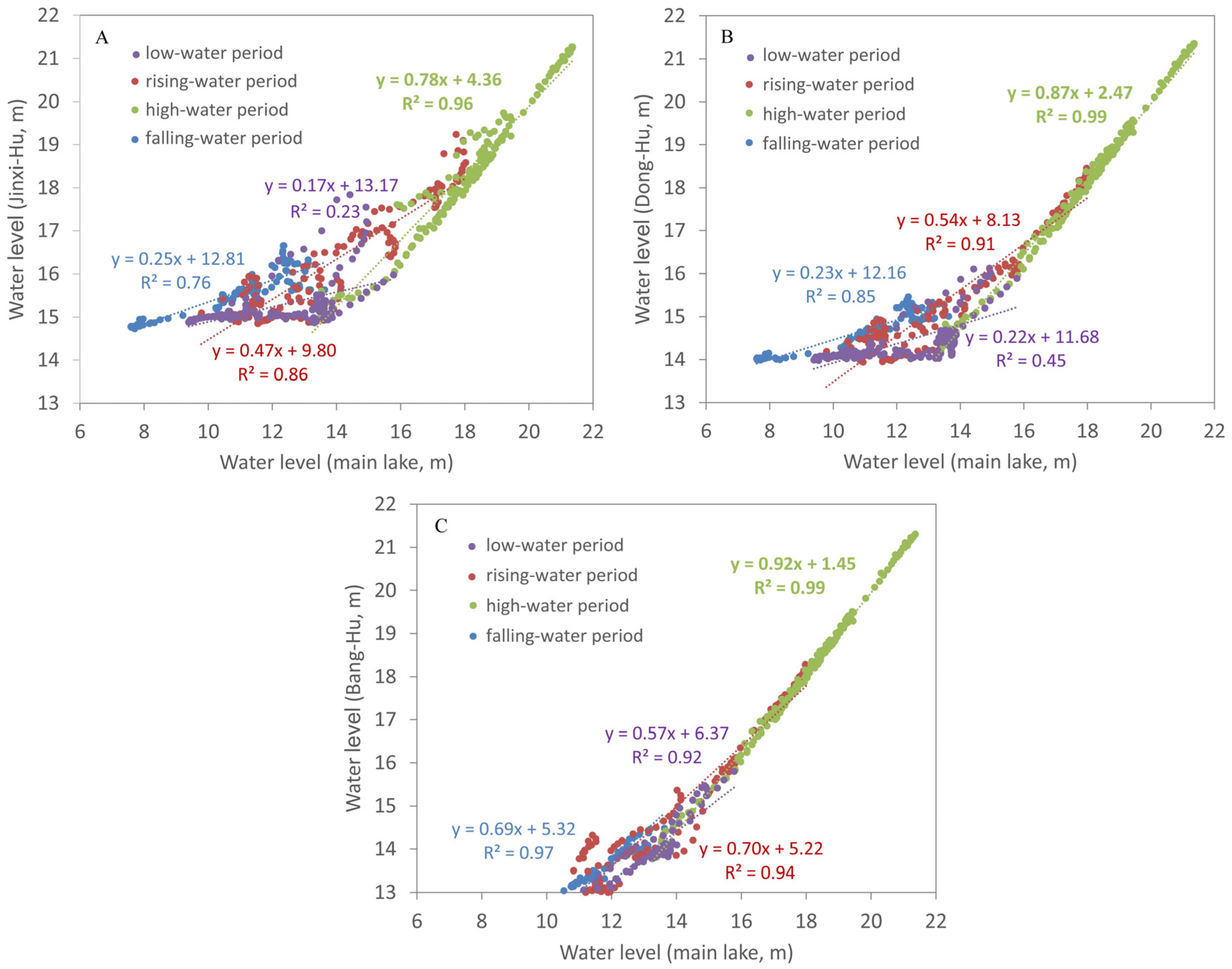Seasonal Water Exchanges between China’s Poyang Lake and Its Saucer-Shaped Depressions on River Deltas
Abstract
:1. Introduction
2. Data and Methods
2.1. Study Area
2.2. Data Acquisition and Analysis Methods
3. Results
3.1. Water Level Fluctuations
3.2. Degrees of Hydrological Connectivity
4. Discussion
5. Conclusions
Acknowledgments
Author Contributions
Conflicts of Interest
References
- Long, C.M.; Pavelsky, T.M. Remote sensing of suspended sediment concentration and hydrologic connectivity in a complex wetland environment. Remote Sens. Environ. 2013, 129, 197–209. [Google Scholar] [CrossRef]
- Arias, M.E.; Cochrane, T.A.; Kummu, M.; Lauri, H.; Holtgrieve, G.W.; Koponen, J.; Piman, T. Impacts of hydropower and climate change on drivers of ecological productivity of Southeast Asia’s most important wetland. Ecol. Model. 2014, 272, 252–263. [Google Scholar] [CrossRef]
- Hudson, P.F.; Colditz, R.R. Flood delineation in a large and complex alluvial valley, lower Panuco basin, Mexico. J. Hydrol. 2003, 1, 229–245. [Google Scholar] [CrossRef]
- Wainwright, J.; Turnbull, L.; Ibrahim, T.G.; Lexartza-Artza, I.; Thornton, S.F.; Brazier, R.E. Linking environmental regimes, space and time: Interpretations of structural and functional connectivity. Geomorphology 2011, 3, 387–404. [Google Scholar] [CrossRef]
- Hayashi, M.; van der Kamp, G.; Rudolph, D.L. Water and solute transfer between a prairie wetland and adjacent uplands, 1. Water balance. J. Hydrol. 1998, 207, 42–55. [Google Scholar] [CrossRef]
- Amoah, J.K.; Amatya, D.M.; Nnaji, S. Quantifying watershed surface depression storage: Determination and application in a hydrologic model. Hydrol. Process. 2013, 17, 2401–2413. [Google Scholar] [CrossRef]
- Leira, M.; Cantonati, M. Effects of water-level fluctuations on lakes: An annotated bibliography. Hydrobiologia 2008, 1, 171–184. [Google Scholar] [CrossRef]
- Raulings, E.J.; Morris, K.; Roache, M.C.; Boon, P.I. The importance of water regimes operating at small spatial scales for the diversity and structure of wetland vegetation. Freshw. Biol. 2010, 3, 701–715. [Google Scholar] [CrossRef]
- Zhang, Q.; Ye, X.C.; Werner, A.D.; Li, Y.L.; Yao, J.; Li, X.H.; Xu, C.Y. An investigation of enhanced recessions in Poyang Lake: Comparison of Yangtze River and local catchment impacts. J. Hydrol. 2014, 517, 425–434. [Google Scholar] [CrossRef]
- Hiatt, M.; Passalacqua, P. Hydrological connectivity in river deltas: The first-order importance of channel-island exchange. Water Resour. Res. 2015, 51, 2264–2282. [Google Scholar] [CrossRef]
- Sabo, M.J.; Bryan, C.F.; Kelso, W.E.; Rutherford, D.A. Hydrology and aquatic habitat characteristics of a riverine swamp: II. Hydrology and the occurrence of chronic hypoxia. River Res. Appl. 1999, 6, 525–544. [Google Scholar] [CrossRef]
- Dutta, D.; Teng, J.; Vaze, J.; Lerat, J.; Hughes, J.; Marvanek, S. Storage-based approaches to build floodplain inundation modelling capability in river system models for water resources planning and accounting. J. Hydrol. 2013, 504, 12–28. [Google Scholar] [CrossRef]
- Karim, F.; Dutta, D.; Marvanek, S.; Petheram, C.; Ticehurst, C.; Lerat, J.; Yang, A. Assessing the impacts of climate change and dams on floodplain inundation and wetland connectivity in the wet–dry tropics of northern Australia. J. Hydrol. 2015, 522, 80–94. [Google Scholar] [CrossRef]
- Coops, H.; Buijse, L.L.; Buijse, A.D.T.; Constantinescu, A.; Covaliov, S.; Hanganu, J.; Staras, M. Trophic gradients in a large-river Delta: Ecological structure determined by connectivity gradients in the Danube Delta (Romania). River Res. Appl. 2008, 5, 698–709. [Google Scholar] [CrossRef]
- Hudson, P.F.; Sounny-Slitine, M.A.; LaFevor, M. A new longitudinal approach to assess hydrologic connectivity: Embanked floodplain inundation along the lower Mississippi River. Hydrol. Process. 2013, 15, 2187–2196. [Google Scholar] [CrossRef]
- Nilsson, K.A.; Rains, M.C.; Lewis, D.B.; Trout, K.E. Hydrologic characterization of 56 geographically isolated wetlands in west-central Florida using a probabilistic method. Wetl. Ecol. Manag. 2013, 1, 1–14. [Google Scholar] [CrossRef]
- Gooseff, M.N.; Wlostowski, A.; McKnight, D.M.; Jaros, C. Hydrologic connectivity and implications for ecosystem processes-Lessons from naked watersheds. Geomorphology 2017, 277, 63–71. [Google Scholar] [CrossRef]
- Finlayson, M.; Harris, J.; McCartney, M.; Lew, Y.; Zhang, C. Report on Ramsar Visit to Poyang Lake Ramsar Site, PR China 12-17 April 2010; Report prepared on behalf of the Secretariat of the Ramsar Convention; The Ramsar Convention of Wetlands: Gland, Switzerland, 2010; Available online: http://archive.ramsar.org/pdf/Poyang_lake_report_v8.pdf (accessed on 15 January 2011).
- Dronova, I.; Gong, P.; Clinton, N.E.; Wang, L.; Fu, W.; Qi, S.; Liu, Y. Landscape analysis of wetland plant functional types: The effects of image segmentation scale, vegetation classes and classification methods. Remote Sens. Environ. 2012, 127, 357–369. [Google Scholar] [CrossRef]
- Hui, F.; Xu, B.; Huang, H.; Yu, Q.; Gong, P. Modelling spatial-temporal change of Poyang Lake using multitemporal Landsat imagery. Int. J. Remote Sens. 2008, 29, 5767–5784. [Google Scholar] [CrossRef]
- Wu, G.P.; Liu, Y.B. Capturing variations in inundation with satellite remote sensing in a morphologically complex, large lake. J. Hydrol. 2015, 523, 14–23. [Google Scholar] [CrossRef]
- Feng, L.; Hu, C.M.; Chen, X.L.; Cai, X.B.; Tian, L.Q.; Gan, W.X. Assessment of inundation changes of Poyang Lake using MODIS observations between 2000 and 2010. Remote Sens. Environ. 2012, 121, 80–92. [Google Scholar] [CrossRef]
- Hu, Z.P.; Zhang, Z.F.; Liu, Y.Z.; Ji, W.T.; Ge, G. The function and significance of the Shallow-Lakes in the Poyang Lake wetland ecosystem. JiangXi Hydraul. Sci. Technol. 2015, 5, 317–323. (In Chinese) [Google Scholar]
- Jiang, J.H.; Huang, Q. Analysis on relationship of water exchange between Banghu Lake and Poyang Lake. J. Lake Sci. 1996, 3, 208–214. (In Chinese) [Google Scholar]
- Shankman, D.; Keim, B.D.; Song, J. Flood frequency in China’s Poyang Lake region: Trends and teleconnections. Int. J. Climatol. 2006, 9, 1255–1266. [Google Scholar] [CrossRef]
- Qi, S.H.; Brown, D.G.; Tian, Q.; Jiang, L.; Zhao, T.; Bergen, K.M. Inundation extent and flood frequency mapping using LANDSAT imagery and digital elevation models. GISci. Remote Sens. 2009, 1, 101–127. [Google Scholar] [CrossRef]
- Karim, F.; Kinsey-Henderson, A.; Wallace, J.; Arthington, A.H.; Pearson, R.G. Modelling wetland connectivity during overbank flooding in a tropical floodplain in north Queensland, Australia. Hydrol. Process. 2012, 26, 2710–2723. [Google Scholar] [CrossRef]
- Hudson, P.F.; Heitmuller, F.T.; Leitch, M.B. Hydrologic connectivity of oxbow lakes along the lower Guadalupe River, Texas: The influence of geomorphic and climatic controls on the “flood pulse concept”. J. Hydrol. 2012, 414, 174–183. [Google Scholar] [CrossRef]
- Drago, E.C. The Physical Dynamics of the River—Lake Floodplain System, in the Middle Paraná River: Limnology of Subtropical Wetland; Springer: Berlin, Germany, 2017; pp. 83–122. [Google Scholar]
- Djebou, D.C.S. Spectrum of climate change and streamflow alteration at a watershed scale. Environ. Earth Sci. 2017, 76, 653. [Google Scholar] [CrossRef]
- Djebou, D.C.S. Integrated approach to assessing streamflow and precipitation alterations under environmental change: Application in the Niger River Basin. J. Hydrol. Reg. Stud. 2015, 4, 571–582. [Google Scholar] [CrossRef]
- Chang, L.Y.; Xu, J.M.; Tie, X.X.; Wu, J.B. Impact of the 2015 El Nino event on winter air quality in China. Sci. Rep. 2016, 6, 1–6. [Google Scholar] [CrossRef] [PubMed]
- Wang, W.; Fraser, J.D.; Chen, J. Wintering waterbirds in the middle and lower Yangtze River floodplain: Changes in abundance and distribution. Bird Conserv. Int. 2017, 2, 167–186. [Google Scholar] [CrossRef]
- Lake, P.S. Ecological effects of perturbation by drought in flowing waters. Freshw. Biol. 2003, 7, 1161–1172. [Google Scholar] [CrossRef]
- Dam Proposal for Poyang Lake Causes Wave of Controversy. Available online: http://www.chinadaily.com.cn/cndy/2011-08/04/content_13045840.htm (accessed on 8 April 2011).
- Qi, S.H.; Liao, F.Q. A study on the scheme of water level regulation of the Poyang Lake hydraulic project. Acta Geogr. Sin. 2013, 1, 118–126. (In Chinese) [Google Scholar]




| Study Sites | Longitude | Latitude | Bottom Elevation (m) | Area (km2) |
|---|---|---|---|---|
| Bang-Hu | 115°57′ E | 29°13′ N | 14.55 | 33.65 |
| Dong-Hu | 116°22′ E | 28°57′ N | 15.06 | 35.78 |
| Jinxi-Hu | 116°18′ E | 28°43′ N | 15.44 | 36.84 |
| Gauging Stations | Longitude | Latitude | Location | Drainage Area (km2) |
| Wanjiabu | 115°39′ E | 28°51′ N | XiuHe | 3548 |
| Waizhou | 115°50′ E | 28°38′ N | GanJiang | 80,948 |
| Lijiadu | 116°10′ E | 28°13′ N | FuHe | 15,811 |
| Meigang | 116°49′ E | 28°26′ N | XinJiang | 15,535 |
| Hushan | 117°16′ E | 28°55′ N | RaoHe | 6374 |
| Year | Lake Phases | Jinxi-Hu | Dong-Hu | Bang-Hu | ||||
|---|---|---|---|---|---|---|---|---|
| Water Level (m) | Date | Water Level (m) | Date | Water Level (m) | Date | |||
| 2015–2016 | rising-water | isolation | 7.61–17.5 | 2/15–6/10 | 7.61–16.1 | 2/15–6/3 | 7.61–14.05 | 2/15–5/16 |
| connection | 17.5–19.46 | 6/10–6/24 | 16.1–19.46 | 6/3–6/24 | 14.05–19.46 | 5/16–6/24 | ||
| falling-water | connection | 19.46–15.81 | 6/24–8/5 | 19.46–15.15 | 6/24–8/7 | 19.46–14.68 | 6/24–8/9 | |
| isolation | 15.81–9.83 | 8/5–3/8 | 15.15–9.83 | 8/7–3/8 | 14.68–9.83 | 8/9–3/8 | ||
| rising-water | isolation | 9.83–17.95 | 3/8–5/12 | 9.83–16.39 | 3/8–4/22 | 9.83–14.23 | 3/8–4/13 | |
| connection | 17.95–21.35 | 5/12–7/12 | 16.39–21.35 | 4/22–7/12 | 14.23–21.35 | 4/13–7/12 | ||
| falling-water | connection | 21.35–14.77 | 7/12–9/5 | 21.35–14.08 | 7/12–9/7 | 21.35–13.59 | 7/12–9/9 | |
| isolation | >14.77 | 9/5– | >14.08 | 9/7– | >13.59 | 9/9– | ||
© 2017 by the authors. Licensee MDPI, Basel, Switzerland. This article is an open access article distributed under the terms and conditions of the Creative Commons Attribution (CC BY) license (http://creativecommons.org/licenses/by/4.0/).
Share and Cite
Wu, G.; Liu, Y. Seasonal Water Exchanges between China’s Poyang Lake and Its Saucer-Shaped Depressions on River Deltas. Water 2017, 9, 884. https://doi.org/10.3390/w9110884
Wu G, Liu Y. Seasonal Water Exchanges between China’s Poyang Lake and Its Saucer-Shaped Depressions on River Deltas. Water. 2017; 9(11):884. https://doi.org/10.3390/w9110884
Chicago/Turabian StyleWu, Guiping, and Yuanbo Liu. 2017. "Seasonal Water Exchanges between China’s Poyang Lake and Its Saucer-Shaped Depressions on River Deltas" Water 9, no. 11: 884. https://doi.org/10.3390/w9110884





